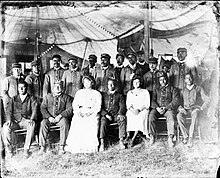| P. G. Lowery | |
|---|---|
 P. G. Lowery holding a cornet P. G. Lowery holding a cornet | |
| Background information | |
| Birth name | Perry George Lowery |
| Born | (1869-10-11)October 11, 1869 Topeka, Kansas |
| Origin | Reece, Kansas U.S. |
| Died | December 15, 1942(1942-12-15) (aged 73) Cleveland, Ohio |
| Genres | |
Perry George Lowery (Topeka, October 11, 1869 – Cleveland, December 15, 1942) was an American composer, conductor, cornet player, and a circus sideshow manager of African American entertainment and musical ensembles.
Early life
Born October 11, 1870, P. G. Lowery came from a musical family. He played the drums in a family band, but later transitioned to cornet.
Musical career
P.G. Lowery spent most of his musical career as a performer, manager, and band leader with different traveling circuses. At the turn of the century the U.S. was a deeply segregated country and economic opportunities were limited. Most African Americans worked in agriculture, domestic work, or unskilled labor. P.G. Lowery and many other Black musicians found opportunities in the circus. The traveling circus was a popular form of entertainment before movies. In the early 1900s every circus had an African-American sideshow band and/or minstrel show.
Early career

In 1895 Lowery performed the cornet in a band for the show Darkest America, with the Mallary Brothers Minstrels. The following year he played with the Wallace Circus. Next Lowery became a cornetist with the Original Nashville Students and P. T. Wright's Colored Comedy Company. In 1897 or 1899 he studied at the Boston Conservatory under the direction of Henry C. Brown. In the summer of 1898 he played solo cornet at the Trans-Mississippi Exposition in Omaha, Nebraska with the Original Nashville Students. And in 1899 he started the P.G. Lowery's Famous Concert Band and P.G. Lowery's Vaudeville Company, an important accomplishment because he was the first African American to bring his own vaudeville troupe to the circus.
During the early 1900s he published a newspaper column, "The Cornet and Cornetists of Today" in The Freeman.
Late career
P.G. Lowery led and managed bands in circus sideshow tents for the remainder of his career. Black band leaders, like P.G. Lowery, "strove toward social and economic equality through hard work and artistic and musical achievement." Lowery worked with the following circuses: Sells Brothers and Forepaugh's Circus, Wallace and Hagenbeck, Ringling Brothers, Cole Brothers, and Barnum and Bailey. His longest stint with a circus was from 1919 - 1931 with the Ringling Brothers & Barnum and Bailey Circus where he managed his own band.
References
- P. G. Lowery and the Spread of African American Music | The Circus, October 11, 2018, retrieved March 6, 2021
- ^ Southern, Eileen (1982). Biographical dictionary of Afro-American and African musicians. Internet Archive. Westport, Conn. : Greenwood Press. ISBN 978-0-313-21339-7.
- ^ Hughes, Sakina M. (July 3, 2017). "Walking the tightrope between racial stereotypes and respectability: images of African American and Native American artists in the golden age of the circus". Early Popular Visual Culture. 15 (3): 315–333. doi:10.1080/17460654.2017.1383028. ISSN 1746-0654. S2CID 191530394.
- ^ Richard, Schwartz (2000). "The African American Contribution to the Cornet of the Nineteenth Century. Some Long lost Names" (PDF). Historic Brass Society Journal. 12: 61–75. doi:10.2153/0120000011003 (inactive January 16, 2025).
{{cite journal}}: CS1 maint: DOI inactive as of January 2025 (link)
External links
- First look clip of new PBS Doc, "The Circus". Short two-minute video about racial discrimination and how PG Lowery changed his sideshow by hiring women and getting rid of blackface.
- P.G. Lowery and the spread of African American Music. Two minute video about Lowery's career and traveling musicians.